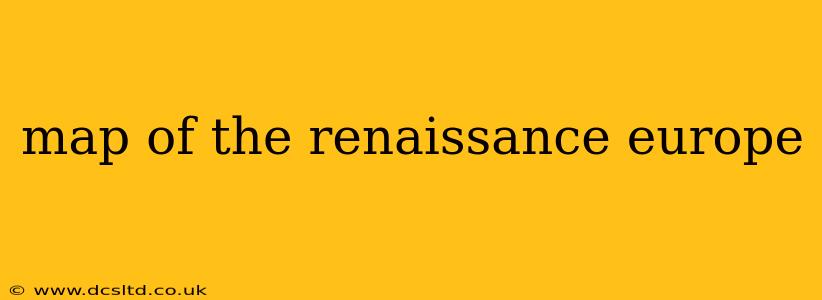The Renaissance, a period of immense cultural and intellectual flourishing, wasn't confined to a single location. It bloomed across Europe, leaving an indelible mark on art, science, literature, and philosophy. Understanding this geographically diverse movement requires more than just a simple map; it necessitates exploring the key players and the interwoven networks that fueled its extraordinary growth. This article will delve into the geographical spread of the Renaissance, addressing common questions and providing a richer understanding of this transformative era.
What countries were involved in the Renaissance?
While Italy is often considered the birthplace of the Renaissance, its influence extended far beyond its borders. Major players included:
- Italy: Florence, Rome, Venice, and Milan were crucial centers, each fostering unique artistic and intellectual styles. The Medici family in Florence, for example, played a pivotal role in supporting artists and intellectuals.
- France: The French Renaissance, though later than its Italian counterpart, flourished under monarchs like Francis I, who actively patronized artists and imported Italian styles. Châteaux like Chambord stand as testament to this influence.
- England: The English Renaissance saw a blossoming of literature, with William Shakespeare as its most iconic figure. The Tudor dynasty also played a significant role in shaping the cultural landscape.
- The Netherlands: The Low Countries experienced a significant artistic renaissance, with masters like Hieronymus Bosch and Pieter Bruegel the Elder producing groundbreaking works.
- Germany: While perhaps less visually prominent than Italy, Germany saw significant intellectual advancements during the Renaissance, particularly in fields like humanism and printing.
- Spain: Spain's Renaissance, largely fueled by its economic power and growing influence, saw a flourishing of art and architecture, often blending with Moorish and Gothic styles.
It's important to note that the Renaissance wasn't a uniform process. Different regions developed at varying paces and exhibited unique characteristics. For instance, the Italian Renaissance focused heavily on classical art and humanism, while the Northern Renaissance emphasized realism and religious themes.
Was the Renaissance only in Italy?
No, while Italy undeniably served as the cradle of the Renaissance, the movement gradually spread across Europe, adapting and evolving along the way. Italian artistic styles, humanist philosophies, and scientific advancements traveled north, inspiring similar developments in other countries. Think of it as a ripple effect, with Italy at the epicenter. However, each nation's Renaissance had its unique flavor, shaped by its own cultural heritage and historical context.
What were the major cities during the Renaissance?
Several cities served as pivotal hubs during the Renaissance:
- Florence (Italy): A center for banking, commerce, and the arts, Florence was the birthplace of many Renaissance ideals.
- Rome (Italy): The historical and religious center of the Catholic world, Rome experienced a significant artistic revival during the Renaissance, with the papacy playing a crucial role as patron.
- Venice (Italy): A powerful maritime republic, Venice was a cosmopolitan center that facilitated the exchange of ideas and goods.
- Milan (Italy): A wealthy duchy, Milan attracted many talented artists and intellectuals.
- Paris (France): The capital of France, Paris became a major center of Renaissance learning and art under Francis I.
- London (England): The capital of England, London flourished culturally and intellectually during the Tudor period.
How did the Renaissance spread across Europe?
The spread of the Renaissance was facilitated by several factors:
- Trade routes: The extensive trade networks connecting Italian city-states with other European countries facilitated the movement of goods, ideas, and artistic styles.
- Patronage: Wealthy patrons, including royalty, the nobility, and the Church, commissioned works of art and supported artists and intellectuals, thus fostering the spread of Renaissance ideals.
- Travel: Artists, scholars, and intellectuals traveled across Europe, disseminating knowledge and inspiring new artistic movements.
- Printing press: The invention of the printing press enabled the rapid dissemination of books and other printed materials, contributing to the wider dissemination of Renaissance ideas.
In conclusion, while the Italian peninsula played a central role in initiating the Renaissance, its impact reverberated across Europe, enriching the cultural landscape of numerous nations. Understanding this geographic breadth is crucial to fully grasping the scope and significance of this transformative period in history. Further research into specific regions and their unique contributions will provide an even richer appreciation of this remarkable era.
